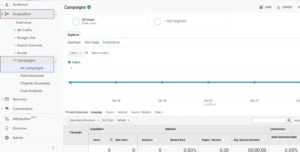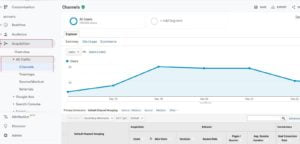Are you in search of the best parameters that you can use to manually track your ad campaign?
- Medium
- Source
- Campaign
These three parameters are used for tracking the engagement of your website. Hang on tight! as we will go over these parameters in depth.
Understanding the source of your audience and tracking the conversions allow you to improve your future marketing strategies. The campaigns can be tracked with the help of Urchin Tracking Modules (UTMs).
UTMs guide you to track the engagement of the visitor on your webpage. Tracking the audience and understanding its activity on specific links of your website will allow you to find the factors that are attracting more audience to your website.
Which campaign parameters can you use to track your audience and understand their engagement on your web pages?
Before diving into the answer to this question, let’s understand the concept of the campaign parameters.
What are the campaign parameters?
Campaign parameters are the tags or text snippets that you can insert in your website URLs. They do not cause any change in the destination of the URL. It will remain the same. These tags just help in tracking the traffic that lands on that specific URL and the source through which the audience has found that link.

What are UTMs?
UTMs refer to the Urchin Tracking Modules. These are the small text snippets that you can insert at the end of a webpage URL to track the audience landing on that page.
After setting up a UTM, you can view the statistics on Google Analytics. It allows you to see the exact source of all your audience and the particular ad that is generating that traffic for your website. Tracking the audience and understanding its behavior enables you to plan your future ad campaigns.
You can place the campaign parameter at the end of a web page URL after the “?” while setting up the UTM.
Why should you set up campaign parameters?
Google Analytics itself provides you with insights into the traffic landing on your webpage. But the data that we get from Google Analytics is all lumped together.
Campaign tracking parameters allow you to study the pattern of your web page visitors in detail and the specific as that are attracting the audience from different platforms to your webpage.
By understanding the best-performing ads you can compare the impact of various marketing platforms and campaigns with accuracy. If you use a single campaign on various marketing channels, UTMs will allow you to collectively study the audience coming from different channels and calculate the overall success of that particular ad campaign.
Campaign parameters are a great way to calculate the Return on Investment (ROI) of different ad campaigns. You can see the content which is driving the maximum conversions and generating more leads. This will enable you to study the impact that online marketing has on your company’s bottom line.
Three campaign parameters to manually track the engagement on your webpages
Medium, Source, and Campaign are the three parameters that are used for tracking the engagement of your website. Let’s have a detailed look at these parameters
1) Medium (utm_medium)
Medium refers to the type of channel that you are using for marketing purposes. For instance, social media, organic search, PPC, or email –are all different mediums of marketing.
You can use this campaign parameter only if you have sufficient data gathered from different marketing channels. For proper estimation, you also need to understand the difference between the audience that is landing on your webpage through the advertisement and the ones that are coming to your page organically from your social media platforms.
This will help you to identify the Marketing channel that is most effective for you. For some people, it might be ‘PPC’ while for others it can be “social media platforms”. So, you can invest your money accordingly to attract the right type of audience to your webpage.
2) Source (utm_source)
This campaign parameter works along with the medium one to guide you about the exact source of your audience. The audience coming from ‘social’ could refer to any of the various social media platforms that you are using for marketing purposes. Source campaign specifies the audience that your particular social media platform is generating. Sources include Facebook, Google, Twitter, YouTube, LinkedIn, and Instagram.
For example, if you run a paid ad campaign on Facebook and LinkedIn, then the visitors coming to your website from both sources will be included in the medium “PPC”. However, the “source” of both audiences would be different.
Using “source” and “medium” together enables you to filter or group your audience more effectively.
If you wish to view the visitors who have landed on your webpage from organic social media, you can sort them by using the medium. The source can then be used to separate the results based on the platform.
You can also compare different types of marketing on the same platform. For instance, you can view the amount of traffic coming from Facebook and then draw a comparison between the results for organic and paid posts.
3) Campaign (utm_campaign)
This allows you to find the specific ad, promotions, or marketing campaigns that your visitors have clicked on to get to your webpage. This parameter is highly recommended for you if you are running multiple campaigns at once. Although it is very difficult to manage, this is an important parameter that enables you to track and compare all your marketing campaigns.
If there are several campaigns that you are running at a time, you can prepare a spreadsheet to keep a track of codes that you are assigning to the different campaigns. Spreadsheets are also helpful if there is a team of different members working on the marketing campaigns.
FAQs
Let’s find the answers to some FAQs related to this topic.
What are campaign parameters?
Campaign parameters are those specific text snippets that you can insert into your webpage URL. They allow you to study the behavior of the audience that lands on your page. So, it enables you to track your website visitors.
Campaign parameters make it easier for you to understand the best advertising strategies for your website that are responsible for landing more customers on your website. They help you to invest your money in the ads that are generating more traffic for your web pages.
What are standard Google Analytics campaign parameters?
Generally, Google Analytics campaign parameters are the tags that you can insert at the end of the blog post or web page address.
Every web page has a URL address starting with “http://www” or “HTTPS://”. By including a “?” at the end of a particular web page’s URL, you can add codes or words also known as “query strings”. It helps Google Analytics to provide you with additional reporting details.
Google identifies five basic UTM tags or parameters – campaign, content, term, medium, and source.
- UTM Campaign – Keep a check on the number of ads that you create per campaign. It allows you to figure out the best-performing ad for your site
- UTM Content – provides you an insight into which Call to action (CTA), image, or content is attracting more customers to your webpage.
- UTM Medium – allows you to identify the most effective mode of communication and media type.
- UTM Source – it helps you to understand which social media platform is bringing more traffic and customers to your page. Is it Facebook, Google, or Twitter?
- UTM Term – assists you in identifying the keyword that the customers are using to get to your product.
What can be used to effectively track the various campaigns that you are running?
Google Analytics is an excellent campaign tracking tool. It makes it convenient for you to track all your ad campaign statistics by bringing them all to one place.
Campaign tracking helps you to figure out the best-performing ad out of all the ads that are running per campaign. It can make your online marketing campaign more efficient. Tracking your campaigns enables you to identify the source of your website traffic. You can also keep an eye on the activity of the visitors to your website.
Tracking the ad campaigns can help you in optimizing your ad campaigns. You can invest more money in the ads that are generating more traffic for your webpage and stop spending on poor-performing ads.
Generally, you can track your ad campaigns in the following categories:
Organic campaigns: which include direct traffic, unpaid search engine results, and email traffic.
Paid campaigns: it includes paid keywords and Social media Ads
Steps to track your campaigns on Google Analytics
Follow these simple steps to track your campaigns:
Login to your Google Analytics account.
- Go to the “Acquisitions” page.
- Select the “Campaigns” option.
- Choose “All Campaigns”
-

By doing so, you will be able to view a summary of all your campaigns and their performance. You can see the number of regular customers and new visitors that have landed on your website. Scroll down to more view statistic options. You can see the activity of the people who landed on your website and the conversion rates.
These statistics will allow you to understand the trends in your website traffic. You can figure out the reason for the success of a particular campaign and fine-tune the poor-performing campaigns according to the collected data.
So, these statistics can be used to attract more internet users to your website.
Generating reports of performance metrics
After tracking your campaigns for a while, you can generate the report sheets to view the performance metrics. For this:
- Click on the “Acquisition” tab
- Select “All Traffic”
- Choose “Channels”

By doing so, you can view trends over a day, week, or month. Scroll down to see your acquisition, behavior, and conversion numbers.
Conclusion
Campaign tracking with the help of Google Analytics can make a significant difference in how you set your ad campaigns. Additionally, you’ll have a more complete picture of the success of your online ads if you create and use customized UTM parameters, set goals, track your campaigns, and identify your conversions. This will also help you to fine-tune your future ad campaigns.
Hope you have a clear idea about the three campaign parameters and their use in manually tracking the ad campaigns. Keep in mind that all the data that you gather from tracking the campaigns is only helpful if you can utilize it effectively.

